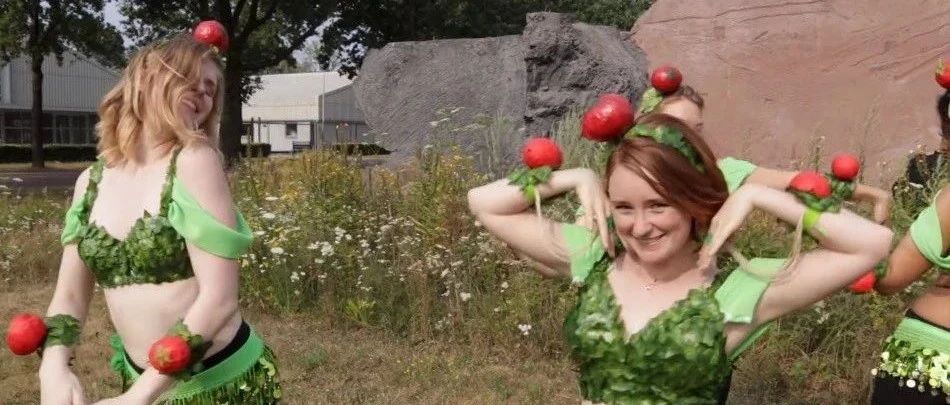
The costume is very cute.
(this article is first published in the fruit shell)
the magical dance competition "Dance your PhD" sponsored by Science recently announced this year's award-winning works ~ as usual, this article will subjectively select one of my favorite award-winning works for a detailed introduction, and briefly introduce other works after the article. If you want to see the full version of all the works, then see the original link: https://www.sciencemag.org/news/2020/02/watch-winner-year-s-dance-your-phd-contest
Tomato belly Dance
this year my choice is the champion of the biological group, entitled "Plant Disease susceptibility genes". There are two main attractions of this dance: contributing doctoral students and partners have carefully designed costumes and props, and the dance form is also a relatively new form of belly dance.
Exhausted of searching for an outstanding beaded dress for prom party? Just check out our new-released affordable options.
(and hand-drawn design manuscripts, which can be said to be very attentive | Katharina Ha)
works best with music appreciation, so first release the full video:
the following is a brief illustration of the picture and text.
Katharina Hanika, a doctoral student, studies plant diseases-specifically, genes that cause disease susceptibility. In the soil, many microbes live around crops, and among them is a fungus called Verticillium dahliae, which infects a variety of crops, including tomatoes, resulting in reduced yields.
this is (somehow colorful) soil and happily growing tomatoes:
next, negative pathogenic fungi come on the scene, causing tomato wilt:
researchers are conducting a new type of breeding for plant disease susceptibility genes (here referred to as the S gene). Very roughly speaking, susceptibility genes are "exploited" by pathogens, making plants susceptible to infection.
however, the usual research scene is probably not this kind of painting style.
the researchers found a clue on the belly of the fallen tomato sister-genes are very important!
since it is a dance program, DNA will naturally have to twist on the stage:
after locking the relevant genes, the research will use the popular technology CRISPR-Cas9 to edit the susceptibility genes of plants. This time, however, instead of comparing nuclease to "genetic scissors", the dancers pulled out a big knife:
after being edited by susceptible genes, plants can increase their resistance to fungi. This time, the fungus is not afraid to come again.
other award-winning works
Champion of the Social Science Group: the experience of juvenile zebrafish affects social avoidance behavior
contributors: Antonia Groneberg
the black-and-white style of this work looks quite high-end, and the content is that if the young experimental animal zebrafish grows up alone, then they are more likely to avoid other similar species. The study also analyzed the neural basis behind these differences in social behavior.
the group on the left is zebrafish that grew up with their companions in the experiment, while on the right is lonely juvenile fish:
what impresses me most about this work is that when enumerating different social animals, the dancers' skills of imitating ants are really unique:
. )
Chemistry group champion: ways to improve the efficiency of microbial bioenergy systems
contributors: Jackie Zorz
probably now the disciplines are all intersected, and it feels that the chemistry group is also quite biological. This is a doctoral project on clean energy, and the researchers hope to use Cyanobacteria to produce bioenergy. However, many problems will be encountered in large-scale culture of these photosynthetic microorganisms, and corresponding solutions need to be found in the study.
for example, the sun is sometimes too strong, damaging microbes. Filter equipment can be added at this time.
(here the sun is using too many photons to bully cyanobacteria)
for example, sometimes cyanobacteria don't get enough carbon dioxide. The alkaline lake (Soda lake) environment with high concentration of carbonate can solve this problem.
(cyanobacteria that cannot capture carbon dioxide. Classmate, you have the wrong carbon dioxide bond angle. )
physical group champion: multi-spectral lidar detection of reduced trees
contributors: Samuli Junttila
this dance introduces: due to climate change, global forests are facing new pressures, including the increase in forest fires and changes in the distribution of diseases and insect pests. Remote monitoring of forest degradation and tree death is necessary, but also challenging, and multispectral lidar is a powerful tool. Dr Samuli Junttila's research team has developed a new method for monitoring changes in water content in tree leaves using multispectral lidar, which can be used to remotely monitor early signs of damage to tree health.
(lighting is cool)
relatively speaking, this work does not have many highlights in dance movements, and the main point is that the contributors have made up a very dynamic rap for their doctoral project. However, the lyrics of rap are all in Finnish, so I can only understand them by subtitles. I feel like I saw a pretty cool MV with no lyrics at all.